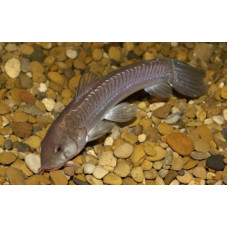Latin name
Callichthys callichthys
Other name
Armored catfish, bubblenest catfish, hassar, or mailed catfish.
Identification
Cascarudo has an elongated, slightly flattened body covered with two rows of bony plates. It has three pairs of whiskers: two on the upper jaw and one on the lower jaw.
Features of fish fins
Dorsal soft rays (total): 6 - 8.
Fish colouring
Females are dull olive green, while males are more vividly coloured with a delicate blue or purple hue on their sides. They also have a more developed, longer reddish-brown pectoral fin with an orange or reddish-orange border.
Distribution
It is widespread in the northern and central parts of South America. Its range extends from Trinidad to Buenos Aires in Argentina and includes the upper Amazon and the Paraguay river system.
Habitat
It inhabits a wide variety of bodies of water, ranging from oxygen-free areas of slow-moving water surrounded by dense vegetation to slightly turbid, free-flowing streams. It can be found in waters with a pH level between 5.8 and 8.3, a water hardness between 0 and 30 degrees Celsius and a temperature between 18 and 28 °C (64 and 83 °F).
Size
This fish will grow to a length of eight inches (20 centimetres). The maximum reported weight is 140.00 grams. Females are larger and sturdier.
Behavior
Obligatory air breathers. They are found in extreme conditions, such as free-flowing streams. When its biotype becomes dry, it can emerge from the water due to its ability to absorb air, using its gut to take in oxygen from the atmosphere in order to find more water.
Food and feeding habits
They feed on fish, insects and plants at night. Juveniles feed on rotifers, microparticles and the larvae of aquatic insects, which they locate by burrowing into the substrate. Small invertebrates such as sludge worms, bloodworms, glassworms and cyclops are the most acceptable food for them.
Reproduction
During the breeding season, the male's abdomen turns orange and his pectoral spines grow longer and thicker. He builds a bubble nest from floating plants and fiercely guards it after the female lays her eggs. The eggs stick to the nest and hatch after 4–6 days.
Relationship with a person
This species is commercially important in the aquarium trade and has secondary importance as a food source. Groups of more than five individuals are recommended for keeping it in aquariums.
Aquarium conditions
The aquarium should be at least 100 litres. The ground should be shallow and preferably without sharp edges. Weekly water changes are required. The dH should be between 5 and 30, the pH between 6 and 8, and the temperature between 18 and 28 °C. They do not tolerate salt in the water and swallow air from the surface.
| Classification | |
| Phylum | Chordata |
| Class | Actinopterygii |
| Squad | Siluriformes |
| Family | Callichthyidae |
| Genus | Callichthys |
| Species | C. callichthys |
| Features | |
| Conservation status | Least Concern |
| Habitat | Bottom |
| Life span, years | No information |
| Maximum body weight, kg | No information |
| Maximum length, cm | 20 |
| Sailing speed, m/s | No information |
| Threat to people | Not edible |
| Way of eating | Planktonophage |
Cascarudo
Tags: cascarudo



